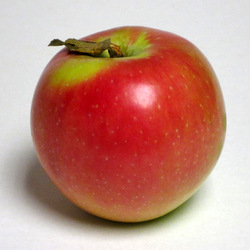An Heirloom Apple a Day
By Meg Klepack, Outreach & Local Food Manager
 “Surely the apple is the
“Surely the apple is the
noblest of fruits.”
– Henry David Thoreau
We have a dizzying array of apples at City Market – crates and crates of dozens of different varieties. How did we come to have so many varieties at City Market? And what do you do with them all? Turns out, there are more varieties of apples (16,000 different ones!) than any other crop.
“As American as Apple Pie,” says a common cliché, but apples are not native trees to America! Apples were among the first crops brought to North America by European settlers starting in the early 1600s. We have apples at City Market that originated in France, England, The Netherlands, Italy, Russia, Germany and more, while most of the modern hybrid varieties were developed in the United States.
Early European settlers depended on apples – and not just as a source of fresh fruit. Many of the apple trees produced fruit that was unpleasant for fresh eating so it was used for cider. This cider was then turned to vinegar which was used for pickling vegetables. Applejack (brandy made from apple juice) was used as a preservative for other fruits.
With modern agriculture a handful of varieties have come to dominate the apple market. One apple variety – the Red Delicious – now comprises 41% of the entire American apple crop.
At City Market, we have a strong relationship with Scott Farm, an apple orchard in Dummerston, VT where they continue to grow over 70 different kinds of apples, helping preserve these old heirloom varieties with their unique flavors, textures, and names.
These heirloom apples come with fascinating stories. Lady Apples, for example, are a small and fragrant apple popular during the Roman Empire. During the Renaissance period, women would keep Lady Apples tucked away in their bosoms and use them as a breath freshener. Thomas Jefferson loved the Newtown Pippin and wrote a letter home from Paris saying, “They have no apples here to compare with our Newtown Pippin.” In 1838 the American minister to Great Britain presented Queen Victoria with a gift basket of these apples and in response Parliament lifted the import duties.
Historical culinary preferences are reflected in the varieties of apples. The French prefer to bake with apples that hold their shape and texture so Calville Blanc d’Hiver was a popular choice. By contrast, the English like their apples to cook to a puree, making the Bramley’s Seedling a popular choice.
Scott Farm’s orchardist, Zeke Goodband, has developed his collection of trees through his travels to old abandoned New England orchards and travels to Europe, going as far as Kazakhstan, the birthplace of apples. In September, we’ll take the City Market Farm Tour to Scott Farm where we’ll meet Zeke, tour his orchards and taste the varieties of apples grown there. We’ll also spend a few hours in a Hard Cider Making workshop – learning to follow the tradition of the European settlers and ferment our own apples. There are still spaces available for the tour – sign up here.
This fall, check out our handy Heirloom Apple guide in the Produce Department. Given that many of our heirloom varieties were developed specifically for baking, drying into apple rings, or making into fresh or hard cider, we’ve got a chart up on our website of all the recommended uses of each of the apples in our collection.
So grab an apple bag, write the name of your apple variety on the side, and get started tasting (or baking) your way through a season of heirloom apples!